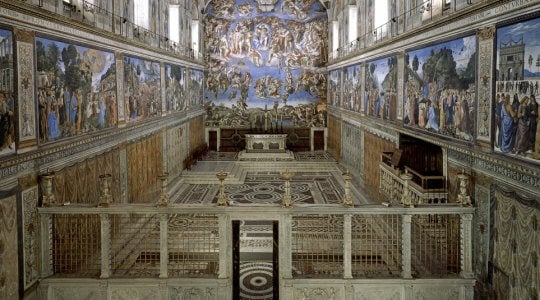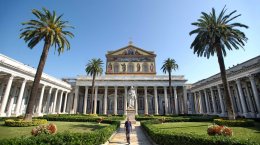Official Reseller Rome and Vatican – Jubilee 2025
Sistine Chapel
The Sistine Chapel, dedicated to Maria Assunta in Cielo, is the main chapel of the apostolic palace, as well as one of the most famous cultural and artistic treasures of the Vatican City, inserted in the tour of the Vatican Museums.


The Sistine Chapel, inside the Apostolic Palace, is located in the Vatican City in Rome. It is one of the most important and significant works of all Western art.
History of the Sistine Chapel
Its name derives from that of Pope Sixtus IV, the pontiff who first commissioned its construction.
The Apostolic Palace was born on the site where the Magna Chapel stood, a place that used to host the meetings of the Pope’s court. Construction work began in 1475 and ended eight years later.
The Sistine Chapel is famous worldwide especially for the fresco on the vault, made by Michelangelo.
To paint the 800 square meters of the ceiling, the painter and sculptor took about four years, from 1508 to 1512.
Why is the Sistine Chapel so important in the history of art?
Despite the very long line to enter the room, visiting the chapel is an experience absolutely worth living.
The ideal situation would be to find a way to admire the frescoes when there are fewer people, perhaps having the good fortune to sit down to discover it and enjoy it in all its beauty. The visitor who enters the room will find himself in a vestibule, the Sala Regia, which precedes the chapel. Once past the Sala Regia, you will find yourself in the magnificent setting of the salon, illuminated by arched windows. Looking up, you will notice the barrel vault, while turning your gaze to the right side you will find the choir, which in the past housed the choir members. The environment is divided into two areas by a fifteenth-century balustrade: one area was reserved for the public; the other was for clerical personnel. When walking along, it is impossible not to be fascinated by the splendid mosaics of the floor.
Pope Sixtus IV, to fresco the hall, called the best artists of the time: Botticelli, Pinturicchio, Ghirlandaio and Perugino. The most important painters of the time worked on the decoration of the walls, which were divided into three horizontal bands. In the lower range were fake drapes; the intermediate one was completed with scenes taken from historical episodes of the Bible: parables of the life of Jesus and Moses; finally, the highest area of the walls, which coincided with the band that enclosed the windows, houses the portraits of some popes.
It was not Sixtus IV but Julius II who called Michelangelo to complete the wall with one of the two frescoes that made the Sistine Chapel famous: The Last Judgment. Michelangelo Buonarroti accepted with many difficulties, as he considered himself more a sculptor than a painter.
The Last Judgment, which stands on the front wall, above the altar, was finished a few years later, when the pontiff was Paul III. The theme of the work is the destiny to which man cannot escape, and of which God is the unquestionable arbiter. In fact, it represents the return of God, in the likeness of Christ, at the end of time, to judge the living and the dead and to begin the kingdom of heaven. When one looks at the wall on which the Last Judgment is frescoed, one cannot but notice the three areas that compose it.
In a first zone the angels are represented, in the second there are Jesus Christ and the Madonna in the midst of the blessed; in the third there is the Apocalypse of John: the angels blow into the trumpets to make the dead rise again and condemn the damned to the flames of hell. What strikes the most is the presence of hundreds of figures painted at different heights, according to the laws of perspective.
The image of Jesus Christ in the center, which judges humanity, stands out in the foreground.
The other significant fresco in the Sistine Chapel was painted on the vault; the theme is that of Creation. The stories of Genesis, the Sibyls and the Prophets, the Ancestors of Christ and the Stories of the Old Testament are represented. Man is immortalized in the image and likeness of God, at the level of which he is raised. It is no coincidence, observing the vault, that the male figure is depicted in all his naked beauty; it is the Renaissance of man in its supreme form, given that human beings, in the various representations, undergo a clear evolution: observing well the chronology created by the paintings of Michelangelo we note how man passes from an imperfect form, in the figure of Noah, and gradually takes on more and more idyllic appearances, up to the magnificence of the Creation.
Monday to Saturday 09:00 a.m. – 6:00 p.m. (final entry 4.00 p.m.)
Every last Sunday of the month (on the condition that this does not coincide with Easter Sunday, June 29, Saints Peter and Paul, December 25 Christmas Day and December 26 Saint Stephen’s Day) 09:00 a.m. – 2:00 p.m. (last entry 12.30 p.m.) Free entry
2018 closures
Sunday (except the last Sunday of each month), January 1 and 6, March 19, April 2, May 1, June 29, August 14 and 15, November 1, December 8, 25 and 26
Visitors are required to leave the halls 30 minutes before the museum closes
For more information http://www.museivaticani.va/content/dam/museivaticani/pdf/utilities/calendario_musei.pdf
To get to the Sistine Chapel, perhaps arriving by train from other regions of Italy, you need to get off at Rome’s Termini Station and take the Metro Line A, direction Battistini. The stop is Ottaviano – St. Peter – Musei Vaticani; alternatively, there is Cipro stop; in ten minutes you arrive at your destination. Those traveling by plane and landing at Leonardo Da Vinci airport can take the train to Termini Station and reach their destination by metro.
From Ciampino airport, instead, take the shuttle to Termini Station.
If you are already in the city and want to reach the Sistine Chapel you can also move by bus. Bus n.49 stops right in front of the entrance of the building that houses the chapel; or you can get to Piazza Risorgimento by bus n.982, 32 and 81; from there you will reach your destination in five minutes
St. Peter’s Basilica, Vatican Museums





